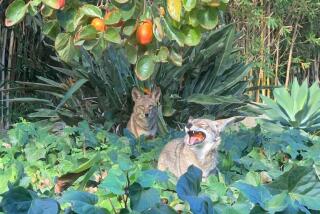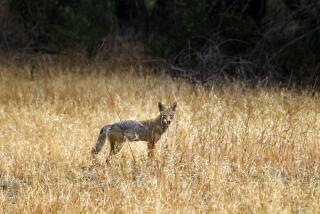Coyotes pose an obstacle at North Carolina airport
- Share via
Raleigh, N.C. — As if baggage, security and traffic aren’t enough of a hassle for the thousands expected to fly in and out of Raleigh-Durham International Airport this holiday weekend, here’s one more thing to worry about: coyotes on the runway.
Airport officials have noted a marked increase in recent months in the number of coyotes crossing the paths of taxiing airplanes. The critters can wreak havoc, causing delays in takeoffs and landings. In September, an American Eagle jet struck a coyote on a runway. No one aboard was injured.
“If we didn’t have some sort of program in place, they’d be unmanageable,” said Michael McElvaney, deputy airport director of operations. “Airports, obviously, have to maintain a safe environment.”
Airport workers and federal wildlife managers usually try to scare the coyotes off runways with cap guns or bottle rockets.
The airport also just put the final touches on a larger wildlife management plan for the Federal Aviation Administration to review.
The proposal recommends a multi-pronged approach, including improving fencing and keeping grasses trimmed low, to manage coyotes and other wildlife on the 5,000-acre airport property.
Biologists in North Carolina hesitate to put a number on the coyote population in the state. But they note that since a migration of coyotes from west to east began in the late 1980s, the animals are now in all 100 North Carolina counties.
“Just like bears, they are good at dispersing into new areas,” said Colleen Olfenbuttel, a black bear and furbearer biologist for the North Carolina Wildlife Resources Commission.
Packs of coyotes, whether small or large, tend to go where food is available, Olfenbuttel said.
More to Read
Sign up for Essential California
The most important California stories and recommendations in your inbox every morning.
You may occasionally receive promotional content from the Los Angeles Times.













